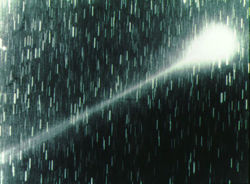- 21P/Giacobini–Zinner
-
21P/Giacobini–Zinner 
Discovery Discovered by: Michel Giacobini, Ernst Zinner Discovery date: December 20, 1900 Alternate designations: 1900 III; P/1900 Y1; 1913 V;
P/1913 U1; 1926 VI; 1933 III;
1940 I; 1946 V; 1959 VIII;
1966 I; 1972 VI; 1979 III;
1985 XIII; 1992 IXOrbital characteristics A Epoch: March 6, 2006 Aphelion distance: 6.014 AU Perihelion distance: 1.038 AU Semi-major axis: 3.526 AU Eccentricity: 0.7056 Orbital period: 6.621 a Inclination: 31.8108° Last perihelion: July 2, 2005 Next perihelion: February 11, 2012[1] Comet Giacobini–Zinner (official designation: 21P/Giacobini–Zinner) is a periodic comet in our solar system.
It was discovered by Michel Giacobini from (Nice, France), who observed the comet in the constellation of Aquarius on December 20, 1900. It was recovered two passages later by Ernst Zinner (from Bamberg, Germany) while observing variable stars near Beta Scuti on October 23, 1913.
During its apparitions, Giacobini–Zinner can reach about the 8th magnitude, but in 1946 it underwent a series of outbursts that made it as bright as 5th magnitude. It is the parent body of the Giacobinids meteor shower (also known as the Draconids).
Giacobini–Zinner was the target of the International Cometary Explorer spacecraft, which passed through its plasma tail on September 11, 1985. In addition, Japanese space officials considered redirecting the Sakigake interplanetary probe toward a 1998 encounter with Giacobini–Zinner, but that probe lacked the propellant for the necessary maneuvers and the project was abandoned.
The comet nucleus is estimated to be 2.0 kilometers in diameter.[1]
References
- ^ a b "JPL Small-Body Database Browser: 21P/Giacobini–Zinner". Jet Propulsion Laboratory. 2006-03-26 last obs. http://ssd.jpl.nasa.gov/sbdb.cgi?sstr=21P. Retrieved 2010-02-25.
External links
- Orbital simulation from JPL (Java) / Horizons Ephemeris
- 21P at Kronk's Cometography
Periodic comets (by number) Previous
20D/Westphal21P/Giacobini–Zinner Next
22P/KopffCategories:- Comets visited by spacecraft
Wikimedia Foundation. 2010.
